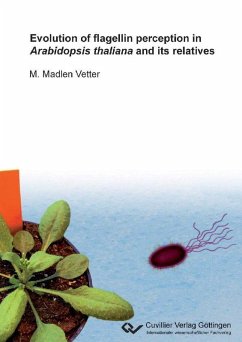Plants are constantly challenged by microbes which try to gain fitness benefits at the cost of their
host. Microbes which may putatively cause disease are therefore detected by plant receptors
that bind pathogen-associated molecular patterns (PAMPs). The peptide flg22 resembles the
most conserved part of the N-terminus of bacterial flagellin and is perceived as a PAMP by the
pattern recognition receptors (PRR) FLAGELLIN-SENSING 2 (FLS2) in all higher plant species.
Upon perception of flg22, FLS2 elicits PAMP-triggered immunity (PTI) and thus contributes
to host survival and fitness. While the evolution of resistance (R) genes has been extensively
examined, no detailed studies on the evolution of PRRs are available, although this information
may improve pest management in crops.
Here, functional variation of FLS2 in A. thaliana and its relatives within the Brassicaceae was
investigated. Differences in FLS2 protein abundance but no major changes in affinity of FLS2
towards flg22 cause functional diversity in accessions of A. thaliana. Duplication of the FLS2
gene in A. lyrata contributes to a large variation in flg22 perception in this species.
FLS2 functional variation correlates with bacteria load in the plant mesophyll. Despite this
beneficial contribution to Darwinian fitness, functional variation segregates within populations
of A. thaliana. The intraspecific variation in flg22 perception in A. thaliana is as pronounced
as among several Brassicaceae species. This suggests that FLS2 is not subjected to directional
selection towards a general optimum of receptor function but flg22 perception is a quantitative
trait in the Brassicaceae family.
Using genetic and quantitative population differentiation to detect natural selection, no
conclusive evidence could be found that evolution of flg22 perception is driven by the adaptation
to local flg22 variants as has been demonstrated for highly specific gene-for-gene interaction of
R genes and their cognate microbial effector molecules. Instead, flg22 perception correlates with
the flg22-triggered inhibition of seedling growth. The genetic basis of inhibition of seedling
growth was investigated by quantitative trait locus mapping and revealed that a locus which
co-localizes with FLS2 partially controls variation in inhibition of seedling growth. Furthermore,
fitness assays with functional and non-functional FLS2 alleles revealed a background-dependent
detrimental effect of FLS2 on reproductive fitness. Moreover, variation in flg22 perception
is correlated with flowering time in A. thaliana giving first experimental evidence that FLS2
function and life-history traits do not evolve independently.
Dieser Download kann aus rechtlichen Gründen nur mit Rechnungsadresse in A, B, BG, CY, CZ, D, DK, EW, E, FIN, F, GR, HR, H, IRL, I, LT, L, LR, M, NL, PL, P, R, S, SLO, SK ausgeliefert werden.

